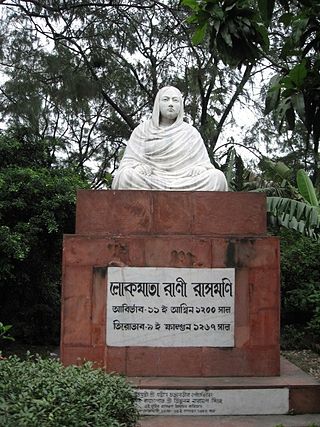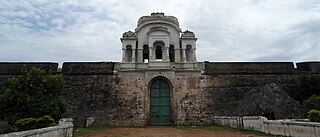Related Research Articles

Sivaganga is a Municipality and headquarters of the Sivaganga district in the Indian state of Tamil Nadu.The Nearest City from Karaikudi at a distance of 45 km.
Kuchesar was a Zamindari Estate of Dalal Jats during the British Raj. It is situated off the NH 24 in what is now of Bulandshahr district, Uttar Pradesh, India, 80 kilometres (50 mi) from Delhi.

Rani Bhabani (1716–1803), also known as Ardhabangeshwari(অর্ধবঙ্গেশ্বরী) and Natorer Rani or the Queen of Natore, was a Hindu zamindar during the British colonial era in what is now Rajshahi, Bangladesh. She became the zamindar after the death of her husband Raja Ramkanta Moitra (Ray), 'Zamindar' of Natore estate. The Rajshahi Raj or Natore estate was the largest zamindari which occupied a vast position of Bengal. The Natore estate had an area of nearly 32,970 square kilometres (12,731 sq mi) and included not only much of North Bengal but also large parts of the areas later comprising the administrative districts of Murshidabad, Nadia, Jessore, Birbhum and Burdwan. After the death of her husband, Rani Bhabani of Natore Rajbari, expanded both the estate and the palace.

Sivaganga District is one of the 38 districts in Tamil Nadu state, India. This district was formed on 15 March 1985 by trifurcation of Ramanathapuram district into Ramanathapuram, Virudhunagar and Sivaganga districts. Sivaganga is the district headquarters, while Karaikudi is the most populous city in the district, administered by the Karaikudi Municipal Corporation. It is bounded by Pudukkottai district on the Northeast, Tiruchirappalli district on the North, Ramanathapuram district on South East, Virudhunagar district on South West and Madurai district on the West. The area's other larger towns include Sivaganga, Kalayar Kovil, Devakottai, Manamadurai, Ilaiyangudi, Thiruppuvanam, Singampunari and Tiruppattur. As of 2011, the district had a population of 1,339,101 with a sex ratio of 1,003 females for every 1,000 males.

Rashmoni Das, popularly known as LokamataRani Rashmoni, also spelled as Rani Rasmani,, was an Indian businesswoman, entrepreneur, Zamindar, philanthropist and the founder of the Dakshineswar Kali Temple in Kolkata. She remained closely associated with Sri Ramakrishna Paramhansa after she appointed him as the priest of the Dakshineswar temple. She was also one of the earliest social reformers in early nineteenth-century Bengal and was one of the forerunners of the Bengal Renaissance. Besides, she also led many of the resistances against the encroaching British administration and their presence in all walks of colonial society in the Bengal province. Her other construction works include the construction of a road from Subarnarekha River to Puri for the pilgrims, Babughat, Ahiritola Ghat and Nimtala ghat for the everyday bathers at the Ganges. She also offered considerable charity to the Imperial Library, and the Hindu College.

The Bardhaman Raj, also known as Burdwan Raj, was a zamindari Raja estate that flourished between 1657 and 1955 in the Indian state of West Bengal. Maharaja Sangam Rai Kapoor, a Punjabi Khatri from Kotli mahalla in Lahore, Punjab, who was the first member of the family to settle in Bardhaman, was the original founder of the house of Bardhaman, whereas his grandson Abu Rai, during whose time the zamindari started flourishing, is considered to be the patriarch of the Bardhaman Raj family.

The Tekari Raj was a zamindari estate of the Bhumihar Brahmin community in South Bihar. They controlled 2,046 villages on their estate, which covered a 7,500 square kilometres (2,900 sq mi) area, near to the town of Gaya.
The estate of Sivaganga, as per British records also known as Kingdom of the Lesser Marava, was a permanently settled zamindari estate in the Ramnad sub-division of Madura district, Madras Presidency, British India. Along the estate of Ramnad, it formed one of the two zamindari estates of Ramnad subdivision.

Rani Velu Nachiyar was a queen of Sivaganga estate from c. 1780–1790. She was the first Indian queen to wage war with the East India Company in India. She is known by Tamils as Veeramangai. With the support of Hyder Ali's army, feudal lords, the Maruthu Brothers, Dalit commanders, and Thandavarayan Pillai, she fought the East India company.

Natore Rajbari was a royal palace in Natore, Bangladesh. It was the residence and seat of the Rajshahi Raj family of zamindars. The famous queen Rani Bhabani lived here and after the death of her husband, expanded both the estate and the palace.

The name is derived from its founder Raja Vijayaram Raj who established a sovereign kingdom by claiming independence from the Kingdom of Jeypore in 1711. It formed alliances with the French and British East India Company to conquer the neighbouring principalities of Bobbili, Kurupam, Paralakhemundi and the Kingdom of Jeypore. However, they fell out with the British and as a result were attacked and defeated in the Battle of Padmanabham. They were annexed as a tributary estate like other principalities and remained so until their accession to the Indian Union in 1949.
Sumitra Charat Ram was a noted Indian arts patron, impresario and the founder of Shriram Bharatiya Kala Kendra (SBKK) established in 1952. She played a key role in the revival of performing arts, especially Kathak, in the post-independence era, for which she received a Padma Shri Award.
Sivaganga Palace is a palace in Sivaganga district, Tamil Nadu, southern India, about 40 kilometres (25 mi) from Madurai. It is an old royal palace, with many historical connections. The palace was used as residence by queens Velu Nachiyar (1780–90), Vellacci Nachiyar (1790–93) and Rani Kaathama Nachiar (1864–77). No remains of the original Sivaganga Palace exist, but a new palace, known as "Gowri Vilasam", was built by Padamathur Gowry Vallabha Thevar (1801-1829) in the year 19th century. A heritage site of Chettinad, it was the property of Rani Velu Nachiar.

Kalipada Singha Thakur was the last King of Malla dynasty of Bishnupur. He became King of Mallabhum in the year 1930 C.E.
Vellacci or Vellachi Nachiyar (1770-1793) was the second ruling queen of Sivaganga estate in 1790–1793. She is the daughter of Muthu Vaduganatha Periyavudaya Thevar and Velu Nachiyar. She was made the heir to the throne of Sivagangai by her mother Velu Nachiyar after the recapture of Sivagangai from the East India Company.

The Nawabs of Dhanbari, also known as the Chowdhury family of Dhanbari, were a Bengali aristocratic family of feudal landowners. The zamindari estate encompassed parts of the Tangali, Jamalpur, Mymensingh and Pabna District, particularly around Dhanbari. Although their aristocratic status was lost with the East Bengal State Acquisition and Tenancy Act of 1950, the Dhanbari estate remains an important part of the history of Tangail and tourist attraction.
Uthumalai, also known as Uttumalai, is a village in the Indian state of Tamil Nadu. It lies in Veerakeralampudur taluk, which itself is in Tenkasi district.
The Narajole Raj was a medieval royal dynasty and later a zamindari (estate) during the British period at Narajole in Paschim Medinipur district in the state of West Bengal. The Raja of Narajole was one of the largest landholders in Midnapore. The kings of Narajole belonged to the Sadgope community and had a close link with the rulers of Karnagarh.

The zamindars of Mahipur were a Bengali aristocratic family of feudal landowners. The zamindari estate encompassed the Chakla of Qazirhat under the Cooch Behar State since the Mughal period. Although their aristocratic status was lost with the East Bengal State Acquisition and Tenancy Act of 1950, the Mahipur estate remains an important part of the history of Rangpur and belongs to one of the eighteen ancient zamindar families of Rangpur. The zamindari palace was lost as a result of flooding from the Teesta River, although the mosque, cemetery, polished reservoir and large draw-well can still be seen today.
Roy Bahadur Ananda Chandra Roy (1863-1920) was a Bengali zamidar and patron of education in Comilla. He founded Comilla Victoria College.
References
- 1 2 Gupta, Aayushi (9 December 2021). "On a portrait of the Rani of Sivagangai: Towards a biography of an 'ethnographic' photograph". Pitt Rivers Museum. Retrieved 12 September 2022.
- 1 2 3 Price, Pamela G. (1996). Kingship and Political Practice in Colonial India. pp. 48–57.
- ↑ Shortt, John. "Habits and Manners of Marvar Tribes of India". Memoirs Read Before the Anthropological Society of London. 3: 201–215.